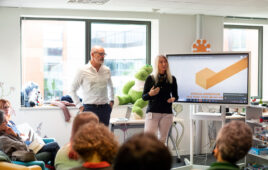It’s, perhaps, of little surprise that Barbara Gerard became CEO of Craftech Industries, Inc., a U.S. high-tech manufacturer of standard and custom parts and fasteners. Her father started the company in 1967, but fasteners were a big part of her childhood.

An example of the PEEK custom parts from Craftech, Inc.
“I remember I was in fourth grade when one of my classmates told me that my dad bought two robots,” she shares. “I didn’t believe it at first. I ran home after school and, sure enough, there were two big machines in the basement of our barn.” Gerard grew up on a farm near Castleton, New York. These “robots” were machines for manufacturing parts.
“I would love to go to the barn and read all of the manufacturing books my dad had and even play around with the machinery,” she says. “He originally managed a small fastener company in Castleton and became very intrigued with the different materials used for these parts, so he started experimenting.”
Gerard says she would help him sort parts on the kitchen table — and would find evidence of her dad’s experiments in interesting places. “For example, I’d go into the freezer for bread or something and there would be frozen bars of nylon or another material my dad would be testing to see how it would resist the cold,” she says. “At one point, a neighbor also started an injection-molding company in Chatham, and my father thought it was the future of fasteners.”
Additionally, a nearby General Electric manufacturing in Pittsfield, Massachusetts was developing plastics. “All of this led to my dad opening Craftech. He didn’t have a lot of money, but he knew the business.” In many ways Gerard’s dad was ahead of his time. Stainless steel was a commonly used material for fasteners but, over time or in harsh conditions, it’s subject to corrosion and rust. However, materials such as nylon or plastic (used by Craftech to this day) offer several benefits, including anti-corrosion qualities and longevity in critical applications.
“And at the time, nylon was big because it doesn’t conduct electricity if used it in electronics,” says Gerard. Eventually, her dad moved his business from Chatham to Stockport, New York. “By then, he began making parts in Delrin and PVC, and then Teflon came along.”
Despite helping her dad out when she was younger, Gerard never planned a career at Craftech. In her early 20s, she went to Manhattan and worked in publishing for a while with Bantam Books. “Books, publishing, writing…that was my dream. But I soon realized how tough it was to earn a living in that industry,” she says.
Gerard also got married and eventually ran a small business with her husband, providing high-gloss lacquer for furniture designer, Karl Springer. “Honestly, this was one of the best decisions I made if only to learn about the hard knocks of business life. There’s a fine line between knowing when to keep going and when to quit. I learned valuable lessons.”
Sadly, Gerard’s father passed in 1985. Her brother ran the business for a while but then Gerard and her husband, Skip Gerard (currently, the president of Craftech), took it over.
“For a while, I wanted a life of my own and what my dad did seemed mundane. But then, his business began to become more interesting to me as technologies developed and the semiconductor industry grew,” she says. “It’s fascinating, really. Without certain kinds of materials such as PEEK plastics, we couldn’t do much with semiconductors. The photoresist process would destroy any metal parts. Titanium is one of the strongest metals on earth, and the acids would eat right into it.”
PEEK (or polyetheretherketone) is a type of plastic that offers high-performance engineering and versatility. The material has an extremely stable chemical structure that’s rare to find in other plastics, making it ideal for use in fasteners in several applications and industries.
“Right now, PEEK is the flavor of the year, but there are always advances and this will likely morph into another material soon. It’s so interesting to watch the new developments,” she says.
Although Gerard gained interest in the family business, taking over Craftech proved challenging at first. “The company was in debt at the time, so we spent a few years shoring it up, buying new equipment, and putting in ISO 9,000 and 9,001,” she says. These are International Organization for Standardization or ISO’s quality management standards. “It was very important to us to guarantee our customers as much efficiency and accuracy as possible.”
This value system has worked well for the company. Craftech went from 10 employees when the Gerard’s took over the company to more than 60 today. Its diverse manufacturing capabilities include injection molding, mold building, screw machining, and CNC machining — which are now all performed in-house at the company’s Hudson-based plant.
“If I could make one suggestion, it would be that more engineers approach us directly when looking for parts or to solve problems. Often there’s a middleman and sometimes the communication link gets broken down,” says Gerard. “We have so much experience to share that working one-on-one with engineers is welcomed and sometimes necessary for critical projects.”
Craftech serves a variety of industries, including aerospace, automotive, chemical, medical, electronics, semiconductor, marine, telecommunications, and others. It can provide standard and custom parts that are traceable and manufactured from low to high volume runs.
“We’ve been quite successful, and I give my husband a lot of credit for that. He’s a very creative engineer. I have an MBA in finance and I run the finance part of our business,” says Gerard. “But I also contribute to our online blog so I still get to write. And I don’t think this industry shares enough information so that’s really important to me to provide that insight.”





Tell Us What You Think!